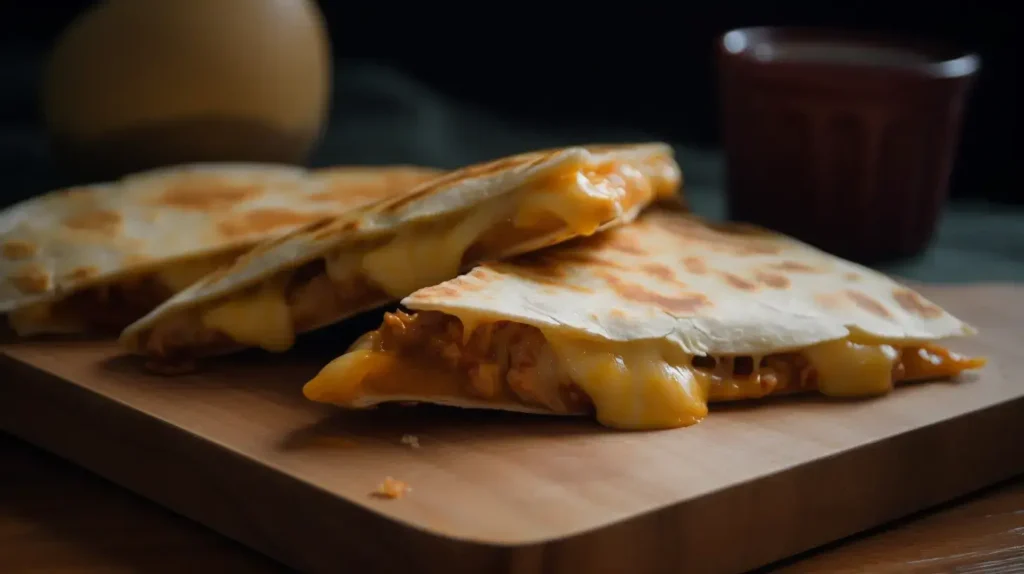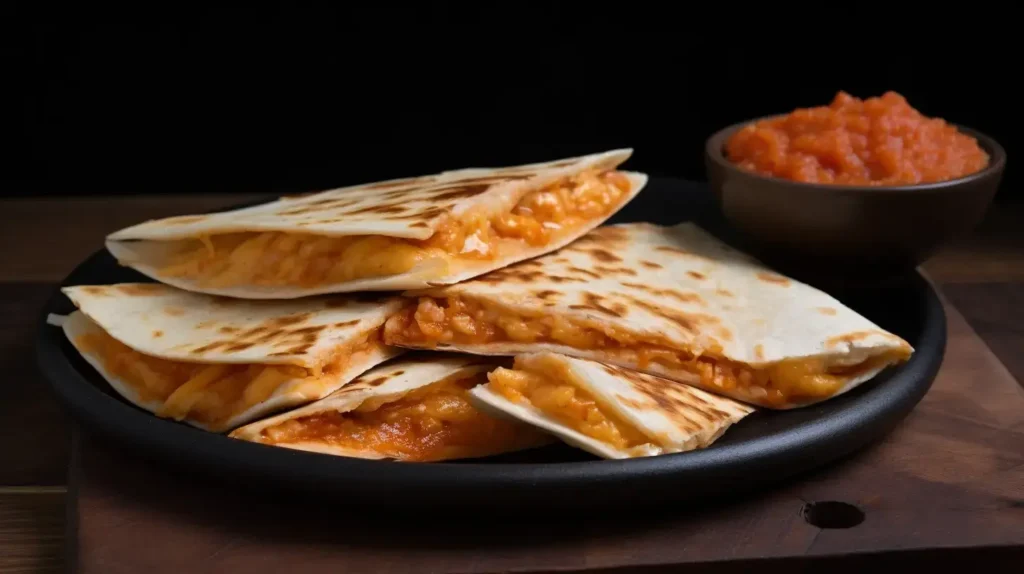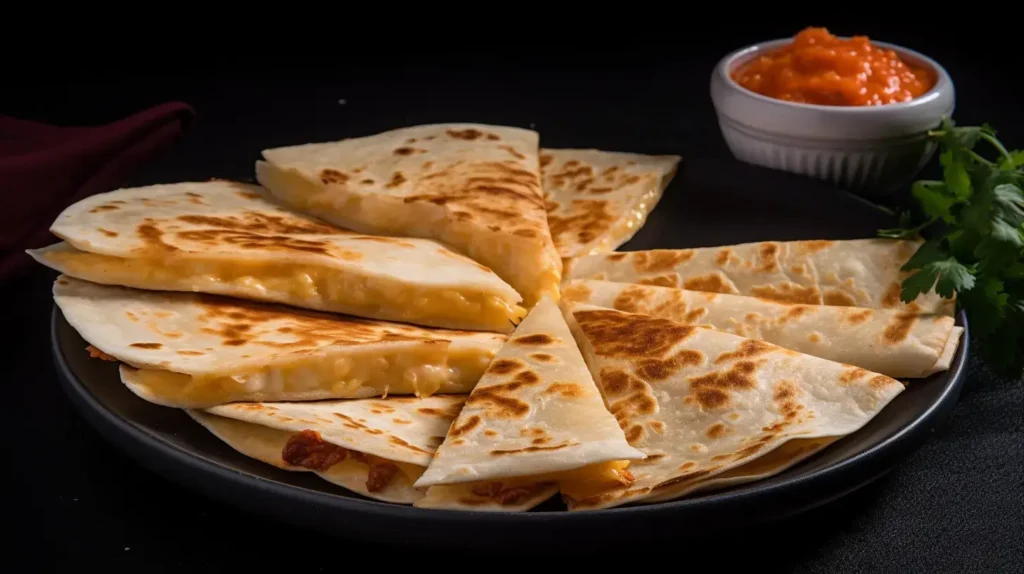Table of Contents
What Are Quesadillas de Maíz?

Quesadillas de maíz are a cornerstone of Mexican cuisine, celebrated for their cultural significance, simplicity, and versatility. Made with corn tortillas (tortillas de maíz), they can be filled with cheese, vegetables, or meats and cooked on a comal (griddle). This dish holds a special place in Mexican culinary traditions, offering both nourishment and a taste of history.
If you’re curious about unique twists, recipes like quesadilla rellena highlight how traditional ingredients are reimagined into flavorful variations. For a comforting winter meal, consider pairing quesadillas with ideas from Indian winter comfort foods.
The History of Quesadillas de Maíz
The origins of quesadillas de maíz trace back to Mesoamerican civilizations, where corn tortillas were staples of daily life. Corn, considered sacred, was nixtamalized to create masa, which is still used today for making tortillas. In central Mexico, quesadillas often feature vegetable-based fillings like squash blossoms or huitlacoche, while in northern Mexico, cheese is more common.
Why Maíz Tortillas Are Special
Maíz tortillas stand apart due to their unique flavor and texture, made possible by the process of nixtamalization. They are not only delicious but also rich in nutrients like fiber and magnesium.
The Evolution of Quesadillas de Maíz Around the World
While quesadillas de maíz are rooted in Mexican culture, they have been embraced globally, with each region adding its unique twist. In some places, chefs experiment with non-traditional fillings, such as spinach and feta or roasted vegetables. These creative interpretations maintain the essence of quesadillas while introducing flavors suited to local palates.
Despite these adaptations, traditional quesadillas de maíz remain popular due to their authentic taste and cultural significance. Restaurants worldwide often include them on menus as a nod to their Mexican origins. The enduring appeal of quesadillas lies in their adaptability; they can be enjoyed as a quick snack, a street food favorite, or a gourmet dish. This global reach underscores the universal appeal of this simple yet iconic dish.
Ingredients and Variations
Quesadillas de maíz are versatile and can be customized based on preferences or regional traditions.
Common Ingredients:
- Corn Tortillas: The base of every quesadilla de maíz.
- Fillings: Cheese (Oaxaca or fresco), huitlacoche, squash blossoms, or mushrooms.
- Condiments: Salsa, crema, or guacamole.
Regional Variations:
Modern Takes: Vegan fillings and plant-based cheeses are becoming popular.
Central Mexico: Focuses on vegetable fillings like huitlacoche.
Northern Mexico: Cheese is essential, often paired with flour tortillas.

How to Make Quesadillas de Maíz
Making your meal at home is simple and rewarding:
- Heat a comal or skillet over medium heat.
- Warm a corn tortilla on the surface.
- Add your chosen fillings, such as cheese or mushrooms, to one half.
- Fold the tortilla in half and press gently.
- Cook until lightly toasted and golden.
Pairing Quesadillas de Maíz With Side Dishes
The versatility of quesadillas de maíz makes them easy to pair with a variety of side dishes. Traditional options include black beans, rice, and fresh salsas. These sides not only complement the quesadilla’s flavors but also add nutritional balance to the meal. Fresh guacamole, with its creamy texture, provides a delightful contrast to the crisp tortillas.
For lighter pairings, consider a salad with lime dressing or grilled vegetables seasoned with chili powder and lime. These options bring brightness and freshness to your plate. If you’re preparing a meal for a special occasion, adding roasted sweet potatoes or spiced corn on the cob creates a festive spread. The key is to pair the quesadillas with sides that highlight the natural flavors of the ingredients, creating a meal that is both satisfying and memorable.
Cultural Significance of Quesadillas de Maíz
Quesadillas de maíz are more than just food—they are a symbol of Mexican identity and culinary heritage. They represent adaptability, turning humble ingredients into dishes that nourish both body and soul. Whether made traditionally or with modern twists like quesadilla rellena, they embody the creativity of Mexican cuisine.
How to Store and Reheat Quesadillas de Maíz
Leftover quesadillas de maíz can be just as enjoyable as freshly made ones if stored and reheated properly. To maintain their texture, store them in an airtight container in the refrigerator. Wrapping them individually in parchment paper can prevent them from sticking together.
When reheating, avoid using a microwave as it can make the tortillas soggy. Instead, warm them on a skillet over low heat until the tortilla regains its crispness. For larger batches, consider reheating them in the oven, placing them on a baking sheet to ensure even heating. With proper storage and reheating techniques, you can enjoy the flavors and textures of your quesadillas without compromising quality.
Why Fresh Ingredients Matter in Quesadillas de Maíz
The quality of ingredients used in quesadillas de maíz plays a key role in their flavor and authenticity. Fresh corn tortillas, often made with masa harina, bring out the true essence of traditional Mexican cooking. Using fresh cheese, vegetables, and other fillings ensures that every bite tastes vibrant and satisfying. Locally sourced produce, such as squash blossoms and mushrooms, can elevate the experience of enjoying this dish.
Authentic quesadillas de maíz often highlight the simplicity of their ingredients. Instead of relying on processed or prepackaged products, focus on incorporating freshly cooked or grilled vegetables. Whether you’re using sautéed mushrooms or tender huitlacoche, the natural flavors shine brightest when the fillings are prepared with care. Pair these with salsas made from fresh tomatoes, cilantro, and peppers to complete a wholesome and flavorful dish. Freshness is the heart of this Mexican classic.
Different Cooking Techniques for Quesadillas de Maíz
Quesadillas de maíz are typically cooked on a comal, a flat griddle that allows the tortillas to achieve a perfect texture. However, other methods can create equally delicious results. For instance, you can cook them on a stovetop skillet, making it easier to achieve a crispy exterior while keeping the fillings warm and melty inside.
For an added layer of flavor, some cooks prefer to lightly toast the tortillas before adding fillings. This creates a firmer base that prevents sogginess. Alternatively, if you’re feeding a crowd, baking quesadillas in the oven can be a convenient way to serve multiple portions at once. Adjust the cooking method based on your preferences and kitchen tools, but always focus on balancing crispy edges with a tender interior. Cooking your meal can be as versatile as the fillings you choose.
Traditional Sauces to Pair With Quesadillas de Maíz
Salsa Roja: A Classic Favorite
Salsa roja, or red salsa, is a traditional accompaniment for quesadillas de maíz. Made from roasted tomatoes, garlic, onions, and chili peppers, it delivers a rich, smoky flavor that complements the earthy taste of corn tortillas. This versatile salsa can range from mild to spicy, depending on the type of chili used, such as jalapeños or guajillos. To prepare, blend the roasted ingredients and cook them briefly to deepen the flavor. Drizzle it over your quesadillas or serve it as a dipping sauce for an authentic Mexican experience.
Salsa Verde: Bright and Tangy
Salsa verde, made with tomatillos, cilantro, and lime, adds a zesty contrast to the warm, savory flavors of quesadillas de maíz. The tartness of the tomatillos brightens each bite, while the cilantro brings a fresh herbal note. This green salsa is particularly popular with vegetarian fillings like squash blossoms or mushrooms. Serve it on the side or drizzle it generously for a flavorful twist.

Popular Vegetarian Fillings for Quesadillas de Maíz
Huitlacoche: Mexico’s Culinary Treasure
Huitlacoche, sometimes called “Mexican truffle,” is a traditional filling that showcases the creativity of Mexican cuisine. This corn fungus has a bold, earthy flavor and a soft, creamy texture, making it a perfect match for quesadillas de maíz. It’s often sautéed with garlic, onions, and chili peppers to enhance its natural richness. Huitlacoche not only tastes amazing but also carries cultural significance as a cherished ingredient in Mexican gastronomy.
Squash Blossoms: A Delicate Delight
Squash blossoms (flores de calabaza) are a light, floral filling commonly used in vegetarian quesadillas de maíz. These delicate flowers are typically sautéed with garlic and a hint of epazote, a traditional herb, to enhance their mild flavor. Their vibrant color and soft texture create a visually stunning and delicious dish. Pair them with a mild cheese or vegan alternative for a balanced and satisfying meal.
FAQs:
Are Quesadillas Always Made With Cheese?
No, many traditional recipes highlight vegetables or other fillings instead.
What Are the Best Fillings for Quesadillas?
Popular options include squash blossoms, mushrooms, huitlacoche, or cheese. For creative combinations, explore quesadilla rellena.
Can Quesadillas Be Made Vegan?
Yes! Use plant-based cheese and fillings for delicious vegan alternatives.
How Can I Make Vegan Quesadillas de Maíz?
Replace the cheese with plant-based alternatives—options like cashew-based queso or almond cheese work well for achieving a creamy texture. For the fillings, use sautéed vegetables like mushrooms, zucchini, or bell peppers. Adding black beans or spiced tofu can enhance the flavor and provide protein. Ensure that your tortillas are made with pure corn masa to keep the recipe fully plant-based. Vegan quesadillas are just as satisfying as traditional ones, especially when paired with fresh salsa or guacamole.
What Are the Best Salsas for Quesadillas de Maíz?
Salsas enhance the flavors of quesadillas de maíz, and there are several varieties to choose from. Traditional red salsa, made with roasted tomatoes and chili peppers, is a classic option. For a smoky flavor, opt for salsa de chipotle or salsa de morita. Green salsa, prepared with tomatillos and cilantro, adds a tangy freshness. For a spicier kick, salsa de habanero is a great choice. Pairing the right salsa with your quesadilla depends on the fillings used, but each adds a vibrant element to the dish.
Can Quesadillas de Maíz Be Made Ahead of Time?
Yes, it can be prepared in advance. Assemble them with your chosen fillings and store them in the refrigerator in an airtight container. To maintain their freshness, place parchment paper between layers to prevent sticking. When ready to cook, simply warm them on a skillet or bake them in the oven. Preparing them ahead of time makes it easy to serve a delicious meal, whether for a busy weeknight or a gathering with friends.
How Can I Add Extra Flavor to Quesadillas de Maíz?
Adding spices and herbs to the fillings can bring out extra flavor in quesadillas de maíz. Season the fillings with cumin, chili powder, or smoked paprika to create a deeper taste profile. Fresh herbs like cilantro or oregano can provide a burst of freshness. You can also experiment with flavored oils, such as garlic-infused or chili-infused oil, when cooking the tortillas. Small additions like these can elevate the taste while staying true to the traditional essence of this dish.
Quesadillas de maíz offers a delicious way to explore Mexican culinary traditions. Their rich history and endless versatility make them a timeless favorite for food lovers everywhere.